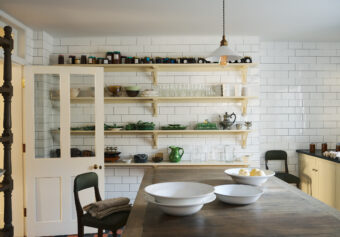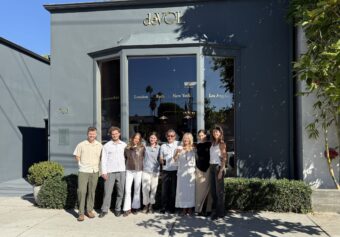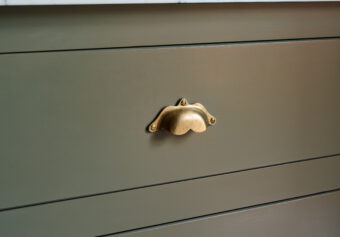An Idiot’s guide to Entrepreneurship
22nd April 2014
Following on from my earlier blog about my first attempt at business, “The Mistletoe Run” I felt like I ought to carry on with a what happened next kind of story. I was just chatting to Jenny, one of our kitchen designers, who is now properly with child and beaming. Although I’ve worked with Jen for nearly ten years, she didn’t know how it all started with me and furniture and deVOL. She actually read the whole blog and was interested to hear where that entrepreneurial spark came from. I was slightly embarrassed, because it was a bit me, me, me, look what I did, aren’t I great. The truth is I made a whole bunch of mistakes along the way, made a lot of money very quickly and also very quickly lost it. The losing of the money was the hardest and most important lesson of them all.
The house I bought at the end of my second year cost £27,500. At the time, a terraced house in Loughborough cost about 10k. 19 Burton Street was enormous, split into 8 self-contained flats over four floors, some of which were large one room flats with a baby belling cooker, others were 2 or 3 rooms, with a proper kitchen and living room. The house came with two sitting tenants, one young girl on the top floor and an elderly lady in the cellar. Her name was Molly Sugden, not the “Are you being served” Mrs Slocombe, but another Molly, who was in her 80’s. She would invite me to have tea with her from lovely china cups and a proper teapot. Her flat was full of beautiful Georgian mahogany furniture. She refused to have a fridge; instead she kept her milk in a bucket of water hanging under the steps up to the front door. Her flat in the cellar was very damp, the joists had rotten away under her floorboards so that they were now resting on soil. Under her bed, the floor had dropped 4 inches below the skirting and she had packed it up with layer upon layer of newspapers.
The previous Landlord had arranged for her to move into temporary accommodation whilst the builders sorted it all out, but Molly got the Collywobbles on the morning when the builders arrived. She sat there sobbing until everyone went away. Molly had lived there for over 30 years; she had never married and had no relatives that she was in touch with. Everyone knew Molly. Unfortunately, Molly wasn’t happy when youths would sit on her wall and twiddle with her bushes, and she would bang on the window and gesticulate for them to clear off. The youths retaliated with various projectiles delivered in the dead of night, which meant that at least one window was always taped up with cellophane. Molly proudly showed her collection of stones and half bricks to any visitors.
In fact, the house bore the brunt of drunken vandalism on many occasions, being on the corner of a nice road and a main road between the centre of town and the largest council estate in Loughborough. It was clearly a student house and Townies and “Stoodents” didn’t mix too well in this old market town. 12,000 students took over the town for 8 months of the year and the locals didn’t appreciate it. One night a Police bollard came through a ground floor flat window and landed on the pillow next to a sleeping tenant. She was horrified and moved out shortly after.
The house proved problematic for a number of reasons. As much as I had done my sums very carefully, I missed some very important details out that would soon have the bailiffs at my door. In all my calculating I had neglected to find out the actual rates payable. I had just estimated a figure. I was out by a long way. The flats were individually rated at around £1000 per year. This took a marginally profitable exercise badly into the red. It took the council about a year to start getting heavy with me. It was the summer after I graduated when the Bailiffs arrived. The students had all moved out and Molly had found a really nice sheltered flat just round the corner. All the bailiffs could find to take was my old black and white portable TV, a ZX81 computer with 1k of memory and a broken hoover; all together worth less than a fiver. They sat on top of the Council Bailiff’s cupboard for the next 9 months, while I desperately tried to sell the house in a market that was turning very rapidly from boom to bust.
There was hope though. House prices had rocketed and this house, now with vacant possession, was on the market for an eye-watering £87,500. With news of an impending house price slump an offer was withdrawn and I was distraught. I went round to the prospective buyer to see if I could change their minds with a much lower price. They weren’t happy to see me; the door was closed in my face and I felt that finally, my bravado and luck had definitely run out. I owed around £50,000, including the Mortgage, overdue Rates and a loan from my girlfriend and I was getting very scared. I earned a little extra cash pavement drawing in Edinburgh, Stratford and Leicester. A good day was £100, most days weren’t that good though. I remember pavement drawing in Edinburgh during the Festival and a football mob piled down Princes street thumping shoppers as they went and kicking our pile of change across the road while we cowered behind a statue.

To cap it all, the house was broken into and badly vandalised, with graffiti all over the cellar. The kids were caught second time around, but nothing could be done; they said the window was already broken and they hadn’t taken anything, and besides they were all under 10 years old! I just wanted to bury my head in the sand, it seemed such a lost cause.
When I’d got myself together, I repainted the house and dropped the price. Another round of viewing and I had another offer of £78,000. I had my fingers crossed for 8 weeks and finally, unbelievably the sale went through. I took the solicitors cheque straight to the bank. “I want to pay off all my debts and put all the remaining 28k in a savings account please”. I was still a very young man to be paying in a cheque of that size. I felt sure the bank would be relieved it all came good for me and be happy to invest the money. But, the cashier returned with a pale face and said “I’m sorry Mr O’Leary, Mr Saunders doesn’t wish you to bank at Barclays anymore.” “What, I can’t believe it, this cheque proves it was all worth it.” “I’m sorry, Mr Saunders says you take too many risks and he would like to sleep at night.” “Ok, I’m sure another bank will be happy to take my money”. They were; but the money didn’t stay there for long. Instead of putting it in a savings account I dabbled in business and learnt some very harsh lessons on the way.
I set up a design consultancy before I even graduated, with a friend from my course. In fact I didn’t even go to my graduation, because we were busy making up prototypes for a client. My parents were pretty disappointed, when they asked when my graduation was and I said “last week”. Poor things; I never really thought of it as a big day for them, just a dull day for me and a waste of money for a flat hat and robes and photographers fees.
Setting up a design consultancy at the beginning of a recession was tough. It’s funny, the thought processes that we had back then; we just didn’t know any better. We worked from home (sensible) and put an ad in the back of Design magazine. When you start advertising you think that you pay your money and then customers appear. Unfortunately I found out that most times you advertise you get no response, none at all; and because you weren’t expecting it, you don’t have a plan b. Luckily we met a guy at our degree show who was an eminent ergonomist and he put some work our way. The first contact he gave us, we designed and prototyped up some TV stands for. I think we did an ok job, and he seemed pleased, but we waited 2 months without being paid. When we finally plucked up courage to confront him, he said it was a matter of “Can’t pay, rather than Won’t pay”. You are left fuming, “why the hell did he ask us to do the work if he had no money”. It was harsh but a good lesson: if you are willing and naïve, there are plenty of people out there that will string you along with promises of big pay-outs in the future if you just do this little thing for me. Expecting people in business to have a conscience will only leave you constantly disappointed.
The Ergonomist fellow also introduced us to contacts at The Royal National Hospital Bath and we did some products to aid the disabled. After our first year we recruited two new designers; one of them Phil, remained my business partner for a decade as the business morphed into deVOL. At the time we thought that getting a prominent office and there now being four of us would make us look more established, so we set about making a fancy boardroom table and some Beetlejuice inspired chairs. They were awful, but with our new office in town, a posh sign and nice projects in the window we felt sure people would take us seriously. However, work was hard to come by, we would take on any project, but most of our time was spent trying to find work. We met someone who was at Cranfield Business College and he asked us to design some branding for him. With nothing better to do we spent all week on it. He was pleased and we were cheap, so he recommended us to some colleagues at Cranfield. We ended up going down to Cranfield every 3 months and doing a presentation to the Entrepreneurs about the importance of branding and signed up clients afterwards. It worked ok, but they were all on tight budgets and we were being paid £100 for a week’s work. That wasn’t enough to pay the rent.
One client we picked up from our office in Loughborough asked us to design a magazine advert for his industrial ventilation business. We did one that he liked and paid for and he came back for another. When we showed that one to him he said it’s practically the same, show me something different. He was a very demanding person and we really wanted to impress him. I came up with this hand drawn cartoony drawing of Marilyn Monroe standing over one of his ventilators with her skirt billowing up. The Caption above read “Don’t get the wind up, get Mansfield Ventilators”.
We proudly presented it to him, whereupon he stared fiercely at the drawing silently. Eventually he muttered “This is a joke, right?” “Errm, no, we thought it was a bit different” He demanded we pay him for the advertising space that he now couldn’t use. We succumbed, after hiding under our boardroom table while he shouted and banged on our front door! I couldn’t help thinking that there must be easier ways to earn a living.
This was the time that my house sold and finally I had some money in the bank and, freed from the burden of debt, I fantasized over an idyllic way of life without angry ventilator man. Two of the partners, Phil and Willy were happy to join me on our new venture.
We would order 3 classic beetle convertibles to be renovated by this specialist garage near Lincoln. They would all look identical in Old English White, a tan leather interior and a black duck cotton hood. We would rent a large villa in the South of France, advertise in the broadsheets and pick up our holidaymakers from their homes and drive them to the South of France, stopping in nice hotels on the way. Whilst we were there we would take our clients water skiing, windsurfing and rock climbing, all our favourite things.
We ordered the beetles with a £1000 deposit each and visited the garage regularly to check on progress. Phil went off to India for a friend’s wedding, while I tried to negotiate a villa for the summer. Unfortunately, most villas with enough rooms looked more like Chateaus, and they wanted half the seasons rent up front to secure it for the season. The money that I was so lucky to make on the house would all be risked on one venture. I started to worry that we didn’t know enough to take the risk. We hadn’t sold a single holiday, not even placed an ad, and I was about to commit everything.
No, it’s too risky, I decided. Poor old Phil came back from India expecting to be heading off to France, only to find we were going to sell the beetles as soon as they were ready. We had negotiated a large discount for ordering three of them; theoretically there was a margin to be made. The three of us turned up at the garage in Lincoln to pay the balance and drive away our beautiful trio of beetles. We thanked them all and drove off as they stood and waved on the forecourt. 200 yards down the road, at the first set of traffic lights, Phil drove straight into the back of a lime green Allegro. The Allegro driver was jumping up and down at the scratch on his bumper, whilst we stared in dismay at the badly folded in beetle bonnet. We were too embarrassed to take them back to the garage, so we drove home. We had been so looking forward to bringing them back to show all our friends, but instead we found ourselves driving in feeling very sheepish. No matter, in a couple of weeks the bonnet was fixed and the cars were in Autotrader. The first one sold quickly with a £1250 profit, the second took a while but we still managed a £400 profit; the last one took months and we eventually sold it at cost. All the same, with one venture written off we needed a new idea. We had enjoyed getting these beetles done and it had shown us that there was money to be made. So we decided our new business would be restoring classic cars. I had bought an Austin Healey Frogeye Sprite and it needed a bit of work doing to it. Our experience in the University workshops should prove useful; we rented the 3 garages in our yard from Claire and bought a frogeye that needed everything doing and set to work on both cars.
I sold my first one with a fibreglass bonnet for £4000, but the next one was a complete rebuild. We took the engine out and stripped it down to the bare body shell. We got Welding Rod, who was a technician from our course, to spot weld on new wheel arches and lead fill them. We wanted it all done properly. We stripped the engine down to every last crank shaft bearing and piston ring. Gave everything a good clean, replaced all the wearing parts and bolted it back together again. The body shell came back from a spray shop and we lovingly reassembled all the pristine parts.
It looked amazing, but could we get the bloomin thing started?! Err no, not even close. The engine needed to be taken back out and sent to an engine specialist to sort out properly. The car failed its MOT because there was so much filler under the chassis that they couldn’t verify it was structurally sound. Oh dear, maybe restoring classic cars wasn’t something you could just have a go at. Maybe it took a lifetime to be good enough to rebuild engines and panel beat bodywork.
All this time I’d been paying Phil and Willy a £100 a week and I was starting to wince at my diminishing bank balance. We needed to find a profitable venture pretty soon or I’d be back to being broke, with no option but to get a job. We all sat down to chat about it and decided that we had proven we could profit from selling cars, but we didn’t have the skills to take on full on restoration projects. We had been approached by an Italian car restorer, mad for Austin Healeys. So we scoured the Autotrader, Exchange and Mart and the classic car mags for wrecks. When we had 3, the Italian chap would send over an Artic and load them in. The cars were so bad that one actually fell in half when we lifted it in. He didn’t mind; 4 weeks later he would send a fax with hundreds and hundreds of parts required. Easy, we could buy it all from one place, Spridgebits in Birmingham. We doubled the price of every part and he paid up and we sent it off in a few big cardboard boxes.
The only trouble was, there were only so many places to buy and it was clear that for most of the week we weren’t able to do anything. We needed to fill in this empty time with some profitable work. So we headed down to the big Car auctions in Measham; it was the biggest in the country and on our doorstep. We knew our limitations and quickly found that silver Ford Focuses and white Escort vans were our best bet. We could spruce them up, steam clean the engine, touch up wheel arches (white and silver didn’t show overspray), put them in the Autotrader and sell them in a few days. It was easy to turn a profit on a 3 year old Fiesta, sometimes making £600 on a car in a couple of days. We had learnt our limitations, we had learnt a lot. We would make some money and I’d see the bank balance edging higher but then we wouldn’t sell a car for weeks. Sometimes we bought a dud and had to get an engine rebuilt. Also, the yard which had the garages at the back, also had three student houses around it. Their back yard was turning into a forecourt.
You don’t do the simplest things when you start in business. I didn’t know what a balance sheet was; I would keep tally of where we were by adding my guess at the value of the cars in stock and add it to the bank balance. With some optimistic imaginings I could convince myself I hadn’t lost that much after all. But, after a year of valeting vans and escorts, on one day we had sold everything except the Austin Healey. I couldn’t fool myself any longer, I had squandered my windfall. There was the car and a couple of thousand. This might possibly be my last chance. We all sat down once more, it was Friday and we needed a new plan. Phil said, let’s all go home for the weekend and write down our ideas, and we can compare them on Monday morning. We knew we wanted to work together, but we just hadn’t found anything that we could do that was profitable in the long run. We had had a few successes, but they were few and far between; we needed to do something that was in demand, that played to our strengths, something a bit more down to earth.
On Monday we went through our ideas and Phil’s was the best: restore antique pine furniture. Great idea; I even had some experience. In my first year at university my girlfriend, Jane E Miller (Dear Jane to my Mum) lived down in Ross on Wye. Life was different there; everyone was a bit more bohemian. Her sister Barbara Miller was a top model who’d been in Vogue and Biba through the late 60’s and early 70’s(The new Twiggy); she had come back home with a rock star called Greg Ridley from Humble Pie (R.I.P. Greg) and set up an old pine shop.

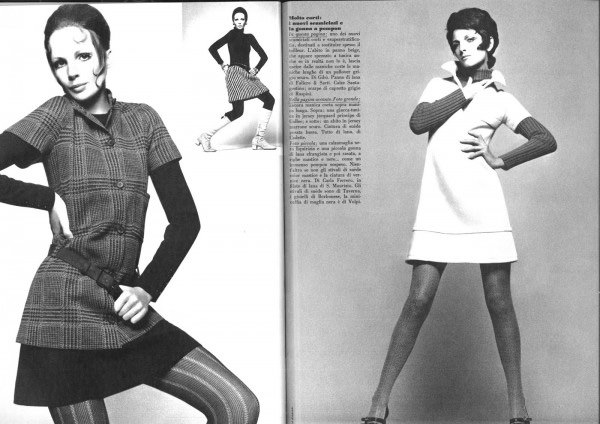
I loved it down there and I worked with Greg stripping pine that he bought from Wales and Ireland. “It’s a messy old game” he used to say; but he was ok with that. Barbara called him “Binny” because before he was a rock star he was a bin man.
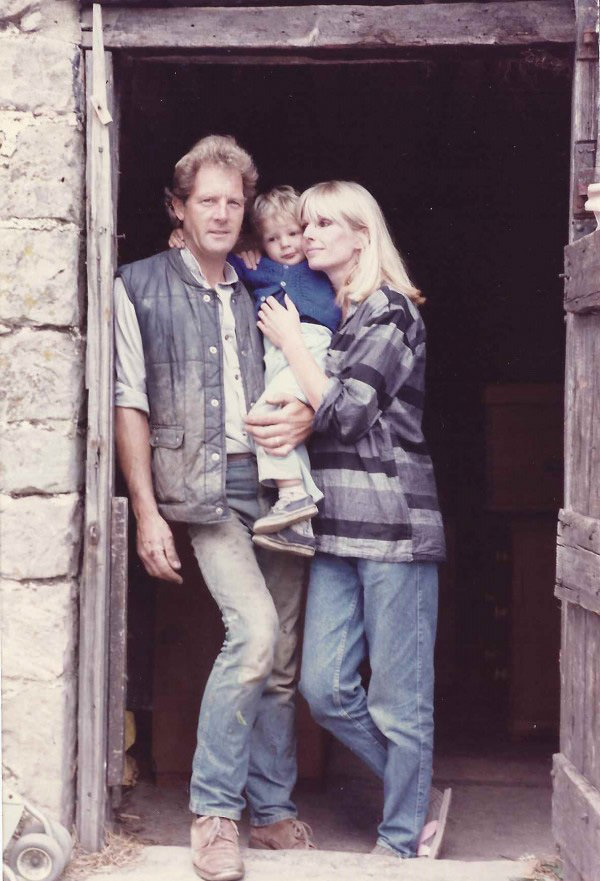
The idea of restoring pine furniture conjured up all my fond memories of the Herefordshire way of life, where Foresters had old bus seats hanging on bog chains in their garden, rather than waste their money in B&Q. Where everyone you met at a party was a musician, an artist, an actor or a photographer. I could listen to their stories all night; I wanted to know all about the fancy hotels the private jets and the groupies. As a young girl, Jane had Michael Jackson on her knee sharing a bag of peanuts, the whole Jackson Five were there. David Bailey was a family friend and this is a picture he took of Jane.
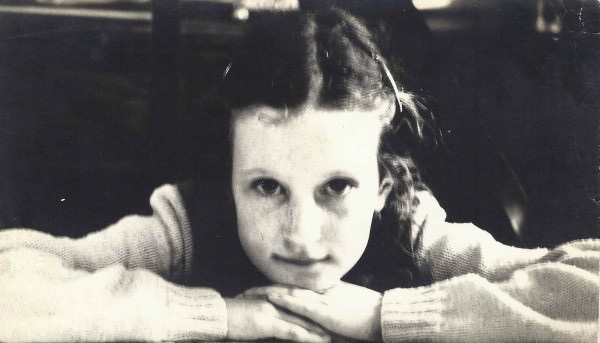
Anyway, Phil and Willy and me headed off to the furniture auctions in Nottingham and bought van fulls of painted pine furniture and set about stripping it. I had a vague recollection of how to do it, so we welded up a 4 ft tank in one of the garages. Claire was having some building work done and the builders were a dry old lot. “That’ll never old water” said one old chap as he sauntered by. We seam welded some wobbly edges and double checked for any little holes. We filled it with a hose and when it was about half full there was a crack and water gushed out of every seam. We stood there, ankle deep in water. “Getting a bit wet in there is it”…..
Ahh well, we re-welded and refilled and dropped in a bag of Caustic soda, gave it a stir and put a chest of drawers in. We checked it after an hour and again after 2 hours and 4 and 8 hours; then we put another bag in and another. The paint wasn’t budging? Ah yes, I remembered it had a heater under it! We had to empty it to lift it to get a gas burner under. Once up to temperature, with one bag it would take all the paint off in 30 minutes. Great, except all the animal glue dissolved too, so some furniture came out flat packed. This is where I learnt how to make furniture, the old way. Putting old furniture back together makes you appreciate every hand-cut detail that somebody with some real skills had a hundred years earlier.
We set about stripping, reassembling and polishing about 30 pieces of furniture with the idea of having an Antique Pine furniture sale between Christmas and New Year. The furniture looked great, spread around the old Victorian courtyard. Willy put signs all round town at 6am “Antique Pine sale this way” The sun was shining we had a great big sign on the yard gates, we settled around a table wondering whether we’d got the prices about right. Then we cracked open a bottle of wine and wondered and waited some more. By late afternoon someone popped their head round the gate; at last a customer. Unfortunately no, it was the neighbour “what’s this all about then”. He was the only one who came. What a miserable day; maybe we just weren’t cut out for this malarkey, business was hard; nothing ever ever went to plan. We may have to think again.
The next morning my bright idea was “If we can strip furniture we can strip doors! Quorn Pine are charging £10 plus VAT, why don’t we put an ad in the local papers: Half Price Door Stripping £5 each NO VAT.” That’s what we did. The first ad came out in the Leicester Mercury and the phone rang, 5 doors in Oadby, and another booking 4 doors in Blaby. When we put the phone down and wondered whether it would ring again, it did; again and again. All of a sudden we had 7 collections in Leicester, Tomorrow. Only trouble is we only had a short wheel base Landrover and you’d struggle to get 4 small doors in. We needed a roof rack. We popped down to the steel yard and bought some 1” box section mild steel and set about welding a roof-rack about 7 foot long. It took longer than we thought and with only two screws holding it on we set off at 7pm. We collected the last set of doors at 11 pm. They looked like they didn’t want to give their doors to us, with the Landy piled high with 30 doors with all their knobs and coat hooks and ropes everywhere.
The tank was too small, every door needed to have one end dipped then the other; it left an obvious line so we bought an old diesel tank from the scrappy which was 6ft long and welded another foot on it. We devised a rack to keep the doors neat and lined up and a pivoting bar to hold them under. It worked a treat, the phone was ringing off the hook, I had a mobile phone the size of 2 bricks and twice as heavy with a 3 foot aerial on it. We had cash in our pockets and we were earning money not losing money.
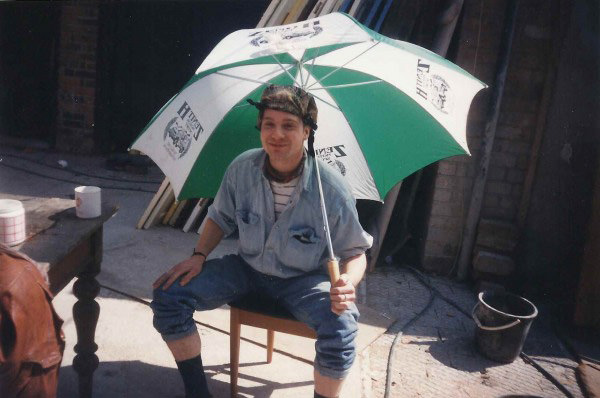
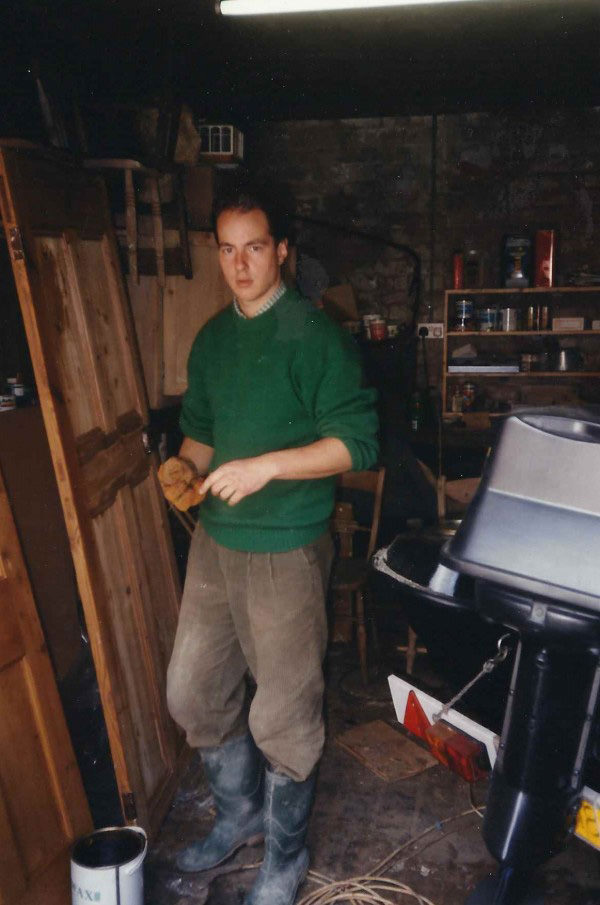
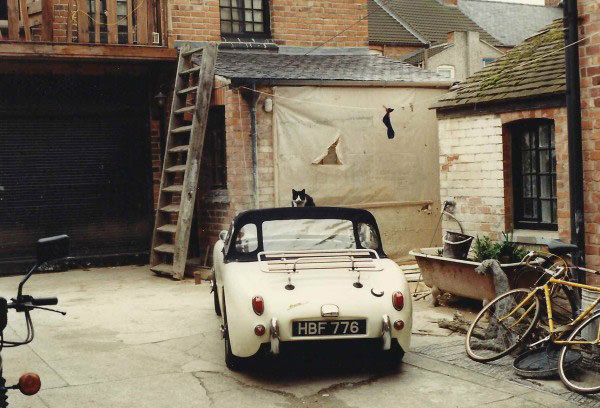
It wasn’t glamorous, you didn’t really need a degree to do it, but we were in business and surviving. And we knew just what a big achievement that was. It didn’t matter how much money you had or how much money you’d lost, what was important was that you made ends meet. That means it’s sustainable, it means you have a chance. Hat’s off to anyone who’s tried it, it’s very nearly impossible.








